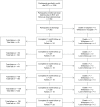Circumstances of falls and falls-related injuries in a cohort of older patients following hospital discharge
- PMID: 23836966
- PMCID: PMC3699056
- DOI: 10.2147/CIA.S45891
Circumstances of falls and falls-related injuries in a cohort of older patients following hospital discharge
Abstract
Background: Older people are at increased risk of falls after hospital discharge. This study aimed to describe the circumstances of falls in the six months after hospital discharge and to identify factors associated with the time and location of these falls.
Methods: Participants in this randomized controlled study comprised fallers (n = 138) who were part of a prospective observational cohort (n = 343) nested within a randomized controlled trial (n = 1206). The study tested patient education on falls prevention in hospital compared with usual care in older patients who were discharged from hospital and followed for six months after hospital discharge. The outcome measures were number of falls, falls-related injuries, and the circumstances of the falls, measured by use of a diary and a monthly telephone call to each participant.
Results: Participants (mean age 80.3 ± 8.7 years) reported 276 falls, of which 150 (54.3%) were injurious. Of the 255 falls for which there were data available about circumstances, 190 (74.5%) occurred indoors and 65 (25.5%) occurred in the external home environment or wider community. The most frequent time reported for falls was the morning (between 6 am and 10 am) when 79 (28.6%) falls, including 49 (32.7%) injurious falls, occurred. The most frequently reported location for falls (n = 80, 29.0%), including injurious falls (n = 42, 28.0%), was the bedroom. Factors associated with falling in the bedroom included requiring assistance with activities of daily living (adjusted odds ratio 2.97, 95% confidence interval (CI) 1.57-5.60, P = 0.001) and falling in hospital prior to discharge (adjusted odds ratio 2.32, 95% CI 1.21-4.45, P = 0.01). Fallers requiring assistance with activities of daily living were significantly less likely to fall outside (adjusted odds ratio 0.28, 95% CI 0.12-0.69, P = 0.005).
Conclusion: Older patients who have been recently discharged from hospital and receive assistance with activities of daily living are at high risk of injurious falls indoors, most often in the bedroom. These data suggest that targeted interventions may be needed to reduce falls in this population.
Keywords: accident prevention; activities of daily living; environment; falls; patient discharge.
Figures
References
-
- Hill AM, Hoffmann T, McPhail S, et al. Evaluation of the sustained effect of inpatient falls prevention education and predictors of falls after hospital discharge – follow-up to a randomized controlled trial. J Gerontol A Biol Sci Med Sci. 2011;66(9):1001–1012. - PubMed
-
- Mahoney JE, Palta M, Johnson J, et al. Temporal association between hospitalization and rate of falls after discharge. Arch Intern Med. 2000;160(18):2788–2795. - PubMed
-
- Lloyd BD, Williamson DA, Singh NA, et al. Recurrent and injurious falls in the year following hip fracture: a prospective study of incidence and risk factors from the Sarcopenia and Hip Fracture study. J Gerontol A Biol Sci Med Sci. 2009;64(5):599–609. - PubMed
-
- Mackintosh SF, Hill KD, Dodd KJ, Goldie PA, Culham EG. Balance score and a history of falls in hospital predict recurrent falls in the 6 months following stroke rehabilitation. Arch Phys Med Rehab. 2006;87(12):1583–1589. - PubMed
Publication types
MeSH terms
LinkOut - more resources
Full Text Sources
Other Literature Sources
Medical
Miscellaneous


